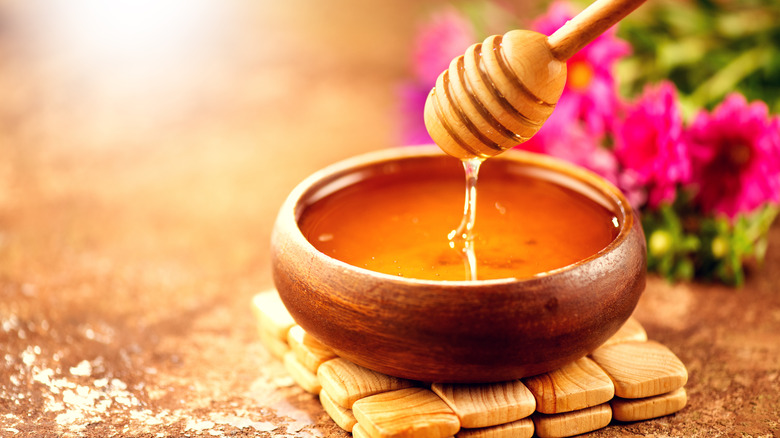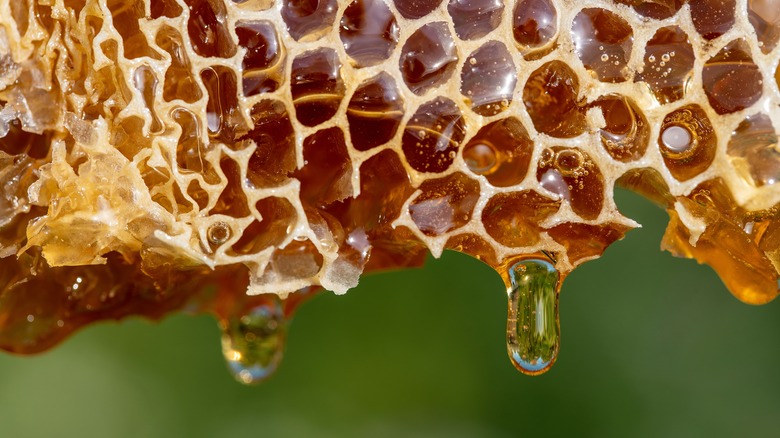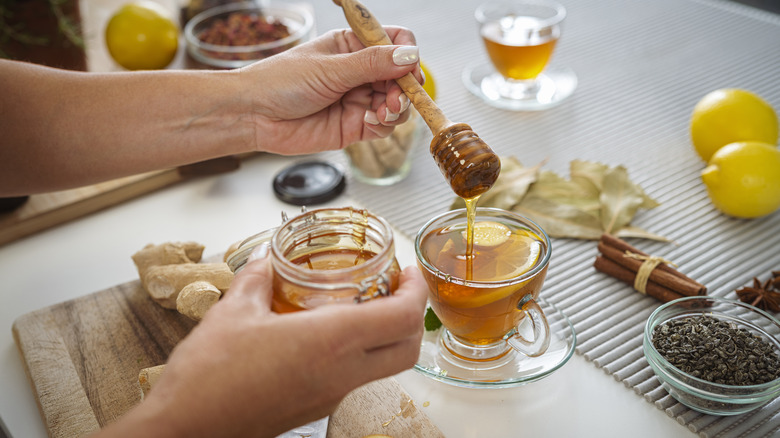The Easiest Way To Tell If Your Honey Is Fake
Is the thick golden syrup that you generously drizzle over your pancakes, yogurt bowls, and toast even honey at all? Chances are, it is anything but. The Honey Authenticity Network claims that up to a third of the honey exchanged across the world is doctored, if not entirely fake. Furthermore, tests conducted by the European Commission found that 46% of 320 honey samples collected from the U.K. were counterfeit (via The Guardian). Fake honey is rampant in America, too: The U.S. Pharmacopeia's Food Fraud Database finds that honey is one of the most popular food items for adulteration, ranking just behind milk and olive oil (via The Economist).
With so much fraudulent honey hiding in plain sight, how can you ensure that what you buy is the real deal? Well, you can tell a lot about the syrup based on what's written on the ingredient list. Honey is the nectar of flowers collected by bees, with nothing else besides faint traces of pollen in it. However, the syrup can be diluted with things like rice or high-fructose corn syrup (which is not the same as standard syrup), unrefined sugar, and even antibiotics. Rather than going by claims of purity on the label — an abundantly used term that has no real legal value — scan the ingredients list for these common suspects. Stick to bottles with only honey on the list and stay away from anything labeled as a blend, as this usually means that it's a blend of honey and other ingredients rather than just the sweet nectar.
Fake honey will have some obvious signs
Ingredients aren't the only signs of fake honey lingering in the bottle: You can also tell a lot about the product's legitimacy based on its taste, texture, and the process used to make it. For example, it's best to steer clear of syrups that are ultra-filtered. Ultra-filtration is a process used to strip honey of its pollen so that its origin cannot be easily determined, meaning the syrup is more likely to be of dubious quality. Instead, look for bottles with True Source Certification marks as these are an excellent way to gauge the origin, authenticity, and quality of honey.
The texture of the syrup is another big one. Contrary to popular belief, real honey is rarely sticky and has a creamy consistency similar to that of thick balm. Anything that feels too treacly is likely doctored with added sugar. Additionally, all honey — whether raw or filtered — will crystallize at some point, and you can find many ways to use the crystallized honey. But, if your syrup seems to perpetually stay in a liquified state, there's likely more than just flower nectar inside.
You can also tell a lot about honey from its taste. Pure honey has a very delicate sweetness followed by a complex and floral aftertaste. On the other hand, adulterated honey generally has a more sickly saccharine flavor that will coat your mouth for far longer after you drink the honey.
Why you should be wary of fake honey
Though consuming adulterated honey isn't exactly unsafe, it's best to be cautious of it. For one, honey has many purported health benefits including vital antioxidants, properties that may improve heart health, and its soothing nature can ease coughs and sore throats. (It's why it's a key ingredient in homemade cough syrups.) You not only miss out on all this goodness when you eat fake honey, but you also have to take into account the effects of the adulterants that you unwittingly consume. For example, honey is often diluted with ultra-processed sweeteners such as corn syrup and refined sugar, both of which are often linked to health problems when consumed in excess.
Another troubling issue is the effect that the abundance of fake alternatives has on beekeepers and honey producers. It takes more than 500 bees to fill up a pound's worth of honey, and when you add to that the depletion of bee colonies and the laborious nature of apiculture, the rich golden syrup isn't exactly cheap to make. To lower its price, some will adulterate the liquid with inexpensive ingredients.
In fact, honey imported from China — the world's leading honey producer per Statista — was slapped with anti-dumping duties worth 221% of its declared value in 2001 by America. Chinese honey was found to be doctored with antibiotics, which unfairly lowered its price tag in the market, adding pressure on beekeepers to match up to the reduced cost of fraudulent honey with their undiluted ones.



